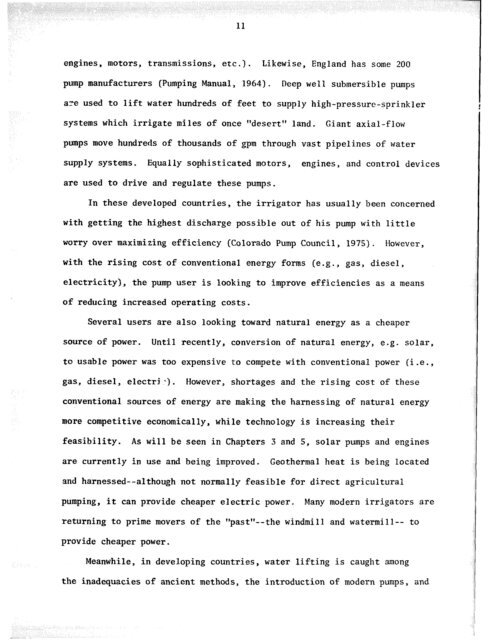MICROFICHE REFERENCE LIBFUUW - Cd3wd.com
MICROFICHE REFERENCE LIBFUUW - Cd3wd.com MICROFICHE REFERENCE LIBFUUW - Cd3wd.com
11engines, motors, transmissions, etc.). Likewise, England has some 200pump manufacturers (Pumping Manual, 1964). Deep well submersible pumpsare used to lift water hundreds of feet to supply high-pressure-sprinklersystems which irrigate miles of once "desert" land. Giant axial-flowpumps move hundreds of thousands of gpm through vast pipelinesof watersupply systems. Equally sophisticated motors, engines, and control devicesare used to drive and regulate these pumps.In these developed countries, the irrigator has usually been concernedwith getting the highest discharge possible out of his pump with littleworry over maximizing efficiency (Colorado Pump Council, 1975). However,with the rising cost of conventional energy forms (e.g., gas, diesel,electricity), the pump user is looking to improve efficiencies as a meansof reducing increased operating costs.Several users are also looking toward natural energy as a cheapersource of power. Until recently, conversion of natural energy, e.g. solar,to usable power was too expensive to compete with conventionalpower (i.e.,gas, diesel, electrj .-). However, shortages and the rising cost of theseconventional sources of energy are making the harnessing of natural energymore competitive economically, while technology is increasing theirfeasibility. As will be seen in Chapters 3 and 5, solar pumps and enginesare currently in use and being improved. Geothermal heat is being locatedand harnessed--although not normally feasible for direct agriculturalpumping, it can provide cheaper electric power. Many modern irrigators arereturning to prime movers of the "past"--the windmill and watermill-- toprovidecheaper power.Meanwhile, in developing countries, water lifting is caught amongthe inadequacies of ancient methods, the introduction of modern pumps, and
the uncertainty of the world's energy situation. In these countries, itis not uncommon to see a farmer pedaling a wooden water paddle, whil?alongside his field runs a high speed railway. The cheap and abundantsupply of human and/or animal power in most developingareas makes themthe prime source of energy for driving water lifters and pumps. Whenmodern pumps and drivers are available in these areas, they are often inpoor condition due to lack of maintenance facilities and parts, and/orproper operational instruction to the user.
- Page 1: MICROFICHEREFERENCELIBFUUWA project
- Page 4 and 5: TABLE OF CONTENTS:.LIST OF FIGURES
- Page 6 and 7: LIST OF FIGURES (CONT)Figure3.163.1
- Page 8 and 9: LIST OF TABLESTable2.12.2a2.2b3.13.
- Page 10 and 11: 2find both new water lifting device
- Page 12 and 13: 4During the 3rd centuryB.C., Archim
- Page 14 and 15: GIn 1698, Thomas Savery obtained a
- Page 16 and 17: 9the United States was starting set
- Page 20 and 21: Chapter 2Water LiftingPrinciples2.1
- Page 22 and 23: 15Table 2.2a Classification of wate
- Page 24 and 25: 2.2.1 Discharge or Capacity (Q)Disc
- Page 26 and 27: (h) Drawdown (D) is the vertical di
- Page 28 and 29: 21Tota I DynamicHeadI Total Static
- Page 30 and 31: 23Vapor Pressure (P,)Suction Fricti
- Page 32 and 33: Multiplying all these efficiencies
- Page 34 and 35: 27NPSHR-Q, is also usually included
- Page 36 and 37: 3.2.1.1 Bucket/BagUtilizing nothing
- Page 38 and 39: handmade construction can be easily
- Page 40: animal is returning to the top, the
- Page 43 and 44: 363.2.1-S Counterpoise LiftThe coun
- Page 45 and 46: 38to return the lever. Combinations
- Page 47 and 48: 40Table 3.1Shadouf performanceLift
- Page 49 and 50: (b)Figure 3.5 Scoop (a) used as sho
- Page 51 and 52: ‘PIVOT-r- ----hFigure 3.6 Wzcer b
- Page 53 and 54: 46water. The capacity of this devic
- Page 55 and 56: - =7?=PIVOTCOUNTER WEIGHT\FLAP- VAL
- Page 57 and 58: 50(a)ROLLER 7- HAND RAIL/SIDE - BY-
- Page 59 and 60: 52flow in through a check-valve (e.
- Page 61 and 62: 54exhaust valves for the steam (or
- Page 63 and 64: 56Another significant difference be
- Page 65 and 66: 58shaft), two other forms of these
- Page 67 and 68: 60Among the simplest designs for a
11engines, motors, transmissions, etc.). Likewise, England has some 200pump manufacturers (Pumping Manual, 1964). Deep well submersible pumpsare used to lift water hundreds of feet to supply high-pressure-sprinklersystems which irrigate miles of once "desert" land. Giant axial-flowpumps move hundreds of thousands of gpm through vast pipelinesof watersupply systems. Equally sophisticated motors, engines, and control devicesare used to drive and regulate these pumps.In these developed countries, the irrigator has usually been concernedwith getting the highest discharge possible out of his pump with littleworry over maximizing efficiency (Colorado Pump Council, 1975). However,with the rising cost of conventional energy forms (e.g., gas, diesel,electricity), the pump user is looking to improve efficiencies as a meansof reducing increased operating costs.Several users are also looking toward natural energy as a cheapersource of power. Until recently, conversion of natural energy, e.g. solar,to usable power was too expensive to <strong>com</strong>pete with conventionalpower (i.e.,gas, diesel, electrj .-). However, shortages and the rising cost of theseconventional sources of energy are making the harnessing of natural energymore <strong>com</strong>petitive economically, while technology is increasing theirfeasibility. As will be seen in Chapters 3 and 5, solar pumps and enginesare currently in use and being improved. Geothermal heat is being locatedand harnessed--although not normally feasible for direct agriculturalpumping, it can provide cheaper electric power. Many modern irrigators arereturning to prime movers of the "past"--the windmill and watermill-- toprovidecheaper power.Meanwhile, in developing countries, water lifting is caught amongthe inadequacies of ancient methods, the introduction of modern pumps, and



